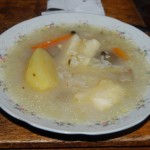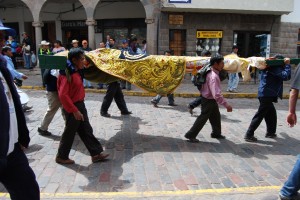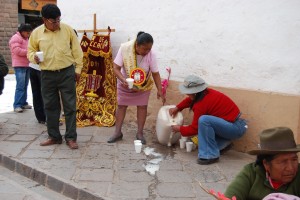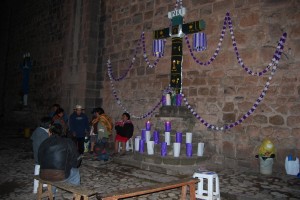Chicken Soup at Midnight


Chicken soup at midnight. That, or beef soup, is what people ate last night, one of the important feast days of Cuzco. Called Cruz Velakuy, or the Vigil of the Cross. More than Catholic, this feast keeps indigenous ways alive, and those include relationships with food.
All the people accompanying the sponsor of the feast, in each neighborhood, sit in a circle and are served, one by one, hot bowls of steaming soup accompanied by canchitas, whole kernels of parched corn. Some people also serve a plate of chiriucho, a dish served cold that is typical of the upcoming season.
Following the food, people are passed glasses of chicha or beer. Another drink, ponche de habas–made from fava bean flour, sugar, cinnamon, cloves, and water with a splash of anisette liqour in each glass — is served both the night of the 2nd and the 3rd. People make toasts and then begin to dance and drink and dance until they are drunk and dawn comes.
Prior to this on May 2nd, people climb the hills to lift the movable crosses. They dress them and bless them with alcohol and with incense. Once lifted they are slowly transported through the city’s streets to the sounds of a brass band which marches with them.
They make frequent stops to rest and drink ponche de habas, before ultimately reaching the house of the jurqado, which in Quechua means the person with the obligation, who is sponsoring the feast for that cross that year.

Similar events happen in families with their own special cross and at the unmovable crosses, usually of stone or concrete and often by churches. Though these latter are not moved, they are still dressed and celebrated.
All night people socialize with the cross to the light of candles, as if it were a special guest. Anthropologist Astrid Stensrud explains:
The saints, the Lords and Virgins, the Taytachas and Mamachas, the Holy Earth, the Hills and the crosses are considered non-human beings who form part of the daily lived experience year-round in the city of Cuzco.

This night, with the Cross as guest in the home of this years sponsors, besides socializing with the cross, the people also jurqar (obligate) the couple that will sponsor the feast next year.
In gratitude for their accepting what is really a burdensome obligation, since it requires considerable expenditure in food, drink and music for all in attendance, people from the neighborhood of the cross, or the household, will bring gifts of special breads that are large and layered, like a layer cake, one small part on top of the much larger base. The bread is slightly sweet and spiced with anise.
The visitors also bring the couple gifts of a shot of pisco and a bottle of beer. In that way the next years sponsors are committed publically. It would be a great shame, now, to not follow through with the obligation.
Once people have made their offerings to the new sponsors, they gather in groups to dance to the sound of a band, provided by the old sponsors, through the streets and around the plaza of the neighborhood before returning to the house of this year’s sponsors. There, a fire is generally lit before the crosses’ altar to drive away the night’s cold.
The helpers of the sponsors offer the guests broad bean punch with a bit of liquor there. At the same time people will go up to the cross, light candles, and offer prayers. People also dance and at 10:00 pm or so they light fireworks in form of castles and pray. They also dance to the live band. It is joy and partying, as well as prayer and food.

The next morning, the 3rd of May, the main day of the Feast of the Cross, the movable crosses are taken in procession accompanied by brass bands to neighborhood temples (churches) to be blessed and hear mass, before returning to the feast sponsor’s home, where another vigil with the characteristic soups will be held that night.
While the Feast of the Cross is part of the Catholic Calendar, it falls at a very important time for Andean peoples who follow traditional ways. This is a time when the earth ceases to produce and becomes open to people. It is also a time when the sun weakens and days get shorter. As a result it is also a season of heavy ritual and many feasts following the harvest.
The sharing of food during this time was part of Inca tradition, according to the Chroniclers. For example Cobo writes.
The sixth month, which corresponds to May, was named Hatun Cuzqui. […] They made a sacrifice to the Sun of a large number of sheep [llamas], of which some were burned and others were distributed among all the people of the city, and they ate their flesh raw with toasted maize [canchas]. There was no one, young or old, who did not eat some of that meat.
Nowadays the meat is not raw, and it is consumed in soup. At the same time, it is still accompanied by toasted corn. And the crosses are celebrated in this month of waning daylight, with flame like the sun.

To say there is continuity, though, is not to deny that there is also significant change. But food, celebration and sharing, sponsorship and obligation (jurqa), are still the same. The hot bowl of soup, just after the fireworks have punctuated the night sky, followed by a glass of the ancient corn drink chicha and the newer fava bean punch is to share is to share in a longstanding idea of socializing with the sky, the earth, the hills, and ones family and friends. In many ways, it is the essence of Cuzco’s life.




